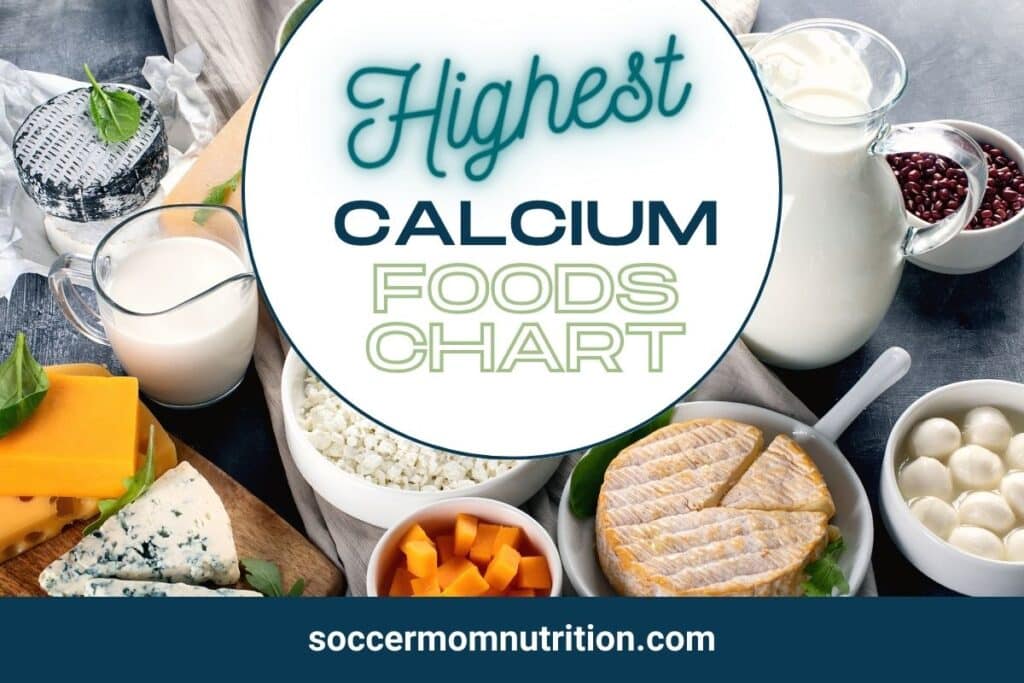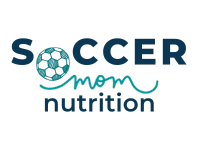Highest Calcium Foods Chart: Guide to Meet Calcium Needs
Calcium is a vital mineral for athletes that plays a crucial role in maintaining healthy bones, muscles and nerve function. Therefore our highest calcium foods chart is an easy resource for athletes to know how much calcium is in their favorite foods.
Adequate calcium intake can help improve bone density, reduce the risk of fractures and other injuries, improve muscle performance and reduce the risk of cramping.
In this blog post, we will explain why calcium is important for athletes, how much calcium you need and give you a high calcium food list.
We will also provide a highest calcium foods chart that you can use as a reference to plan your soccer player diet.

Why is calcium important for athletes?
Calcium is the most abundant mineral in your body because your skeleton is made of collagen and calcium. Your body stores most of its calcium in bones and teeth, where it provides strength and structure.
Calcium also functions as an electrolyte within your body, carrying an electrical charge and playing a major role in regulating several of your body’s physiological processes.
Processes such as heart activity, muscle contraction, nerve transmission, blood clotting and hormonal secretion rely on calcium.
Athletes need calcium because it is essential for the health of their bones, muscles, nerves, blood and heart. Calcium helps to prevent bone loss, muscle cramps, blood pressure fluctuations and irregular heartbeat.
How much calcium do athletes need?
The amount of calcium you need depends on your age, sex and physical activity level. The recommended dietary allowances (RDAs) for calcium for all age groups are:
| Age | RDA for Calcium (mg/day) |
|---|---|
| 0-6 months | 200 |
| 7-12 months | 260 |
| 1-3 years | 700 |
| 4-8 years | 1000 |
| 9-13 years | 1300 |
| 14-18 years | 1300 |
| 19-50 years | 1000 |
| 51-70 years (men) | 1000 |
| 51-70 years (women) | 1200 |
| 71+ years | 1200 |
Source: National Institutes of Health
The best way to assess your calcium intake is to keep a food diary and use a nutrition calculator or app to track your intake. Use our highest calcium foods chart to find your favorite calcium-rich foods.
You can also consult with a registered sports dietitian nutritionist to get personalized advice on your calcium needs.
What are the best sources of calcium?
The best sources of calcium are foods that naturally contain or are fortified with calcium. Some examples of highest calcium containing foods are:
Dairy products
Dairy products are among the best sources of calcium because they also provide other nutrients that support bone health, such as protein, phosphorus, magnesium, zinc, vitamin D and vitamin K. High protein milk has even more calcium than regular milk.
Some examples of dairy products that are high in calcium are:
| Food | Serving Size | Calcium (mg) |
|---|---|---|
| Milk (skim, low fat, whole) | 1 cup | 300 |
| High protein milk | 1 cup | 380 |
| Chocolate milk | 1 cup | 280 |
| Buttermilk | 1 cup | 300 |
| Eggnog | 1 cup | 330 |
| Dry milk | 1/4 cup | 330 |
| Yogurt, plain, nonfat | 8 oz | 488 |
| Yogurt, plain, low fat | 8 oz | 448 |
| Low fat Greek plain yogurt | 8 oz | 260 |
| Non fat Greek plain yogurt | 8 oz | 250 |
| Kefir, plain, low fat | 1 cup | 317 |
| Cottage cheese | 1 cup | 130 |
| Cheese (cheddar, muenster) | 1 oz | 200 |
| Cheese (parmesan, feta) | 1 oz | 300 |
| Cheese (ricotta) | 1/2 cup | 340 |
| Sour cream | 1/2 cup | 120 |
| Ice cream or frozen yogurt | 1/2 cup | 100 |
| Pudding or custard | 1/2 cup | 150 |
| Whey protein isolate | 1.2 oz | 160 |
Plant based milk
Fortified plan based milks can be a good high calcium food source. So, make sure to check the food label to ensure it contains calcium and vitamin D.
| Food | Serving Size | Calcium (mg) |
|---|---|---|
| Soy milk, calcium fortified | 1 cup | 200 to 400 |
| Soy milk yogurt, plain | 8 oz | 300 |
| Almond milk, fortified | 1 cup | 300-450 |
| Oat milk, fortified | 1 cup | 350 |
| Rice milk, fortified | 1 cup | 284 |
Fish and seafood
Fish and seafood are another good source of calcium, especially if you eat them with the bones. Some examples of fish and seafood that are high in calcium are:
| Food | Serving Size | Calcium (mg) |
|---|---|---|
| Sardines (with bones) | 3 oz | 325 |
| Salmon (with bones) | 3 oz | 180 |
| Shrimp | 3 oz | 125 |
| Oysters | 3 oz | 80 |
Fruits
Fruits are not only delicious but also provide some calcium, along with other vitamins, minerals and antioxidants. Some examples of fruits that are high in calcium are:
| Food | Serving Size | Calcium (mg) |
|---|---|---|
| Dried figs | 1/2 cup | 120 |
| Oranges | 1 medium | 60 |
| Kiwifruit | 1 medium | 30 |
| Blackberries | 1 cup | 40 |
| Grapefruit juice, 100%, fortified | 1 cup | 350 |
| Orange juice, 100%, fortified | 1 cup | 350 |
Vegetables
Vegetables are low in calories but high in vitamins, minerals, antioxidants, and fiber. They also provide some calcium, especially dark green leafy vegetables. Some examples of vegetables that are high in calcium are:
| Food | Serving Size | Calcium (mg) |
|---|---|---|
| Kale | 1 cup (cooked) | 180 |
| Collard greens | 1 cup (cooked) | 260 |
| Spinach | 1 cup (cooked) | 240 |
| Bok choy | 1 cup (cooked) | 160 |
| Broccoli | 1/2 cup | 90 |
Some vegetables have higher calcium content than others, and some may also have substances that can interfere with calcium absorption.
Look for dark green leafy vegetables, such as kale, collard greens, turnip greens, mustard greens, beet greens, bok choy and broccoli raab. These are some of the highest calcium vegetables, with more than 100 mg per cup cooked.
Oxalates and phytates are compounds that can bind to calcium and reduce its absorption.
Tofu, beans, seeds and lentils
Beans and lentils are excellent sources of plant-based protein, fiber, iron, folate, and calcium. They can be used in soups, salads, dips, and curries. Some examples of beans and lentils that are high in calcium are:
| Food | Serving Size | Calcium (mg) |
|---|---|---|
| Soybeans (cooked) | 1 cup | 260 |
| Tofu (prepared with calcium sulfate) | 1/2 cup | 430 |
| Tempeh | 1/2 cup | 95 |
| Tahini (sesame seed butter) | 1 tbsp | 154 |
| Edamame (green soybeans) | 1/2 cup | 50 |
| Navy beans (cooked) | 1 cup | 125 |
| Black beans (cooked) | 1 cup | 100 |
| Kidney beans (cooked) | 1 cup | 75 |
| Chickpeas (cooked) | 1 cup | 80 |
| Lentils (cooked) | 1 cup | 40 |
| Hummus | 1/4 cup | 60 |
Fortified foods
Some common athlete snacks are fortified with calcium and other vitamins and minerals. The amount varies by brand and type so you should always check the nutrition facts panel for the most accurate information.
| Food | Serving Size | Calcium (mg) |
|---|---|---|
| Cold breakfast cereal | 1 cup | 250 to 1000 |
| Bread | 1 slice | 150-200 |
| Granola bar | 1 bar | 50 to 200 |
| Energy bar | 1 bar | 100 to 300 |
| Crackers | 5 crackers | 50 to 150 |
| Cookies | 2 cookies | 50 to 100 |
| Pretzels | 10 pretzels | 50 to 100 |

How to incorporate calcium into your diet
Now that you know the best sources of calcium, you may wonder how to incorporate them into your diet. Here are some tips and ideas to help you increase your calcium intake:
- Start your day with a calcium-rich breakfast. Have a bowl of fortified cereal with milk or yogurt, a glass of fortified orange juice or a smoothie made with yogurt, high protein milk and fruits.
- Snack on calcium-rich foods throughout the day. You can have cheese cubes, yogurt cups, cottage cheese, almonds, dried figs or sesame bars.
- Add calcium-rich foods to your salads, sandwiches, soups, and casseroles. Use cheese, tofu, kale, broccoli, sardines, salmon or almonds as ingredients or toppings.
- Enjoy calcium-rich desserts such as ice cream, pudding, custard or chocolate milk.
- Choose calcium-fortified foods and beverages, such as orange juice, soy milk, cereals and breads.
- Eat foods that are high in vitamin D, such as fatty fish, egg yolks and mushrooms. Vitamin D helps your body absorb calcium better.
High calcium foods FAQ
Final thoughts
Calcium is an important mineral for youth athletes, since it helps maintain strong bones and teeth, supports muscle and nerve function, and protects against osteoporosis.
Youth athletes should aim to get enough calcium from their diet by eating a variety of calcium-rich foods from this highest calcium foods chart and beyond, every day.
You can find ways to include high calcium foods in snacks and meals, such as chocolate milk for a recovery drink and yogurt and berries for a healthy snack.
Dairy products are the best sources of calcium, but there are also many non-dairy sources that can provide adequate amounts of calcium.
If you have any questions or concerns about your calcium intake or bone health, you should consult your doctor or a registered sports dietitian nutritionist.
Stephanie Magill, MS, RD, CD, FAND has over 22 years of experience in public health and nutrition. As a performance registered dietitian nutritionist, Stephanie specializes in sports nutrition and provides simple and actionable information so that athletes can be well fueled for high performance on and off the field. Stephanie has a Master’s Degree in Nutrition and is a Fellow of the Academy of Nutrition and Dietetics.

